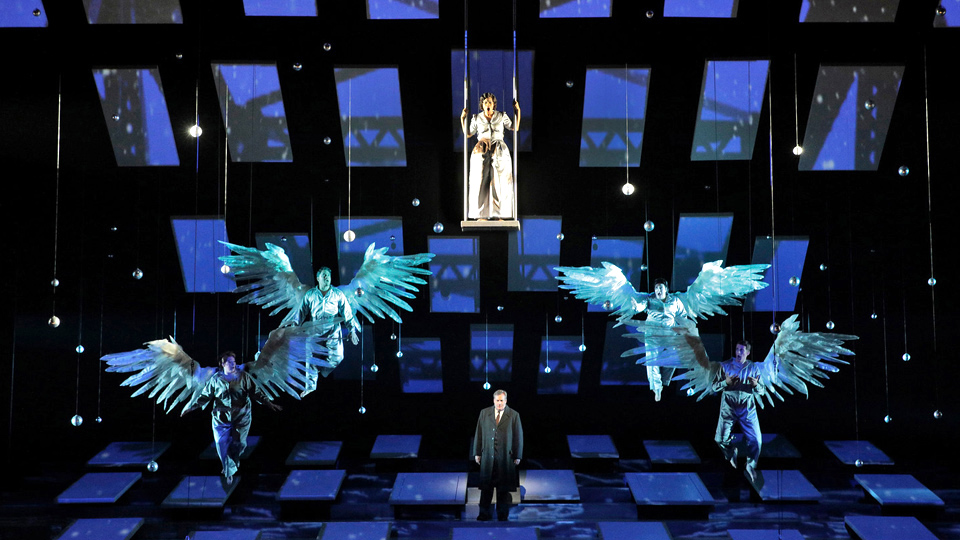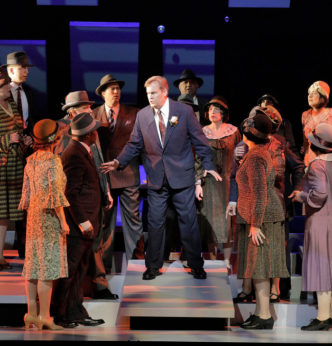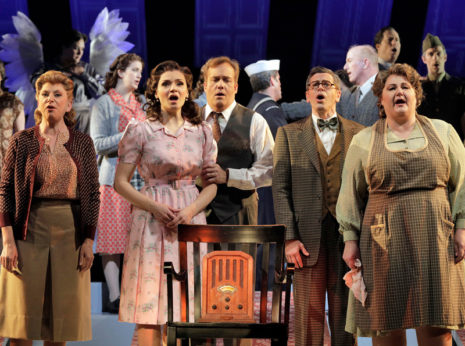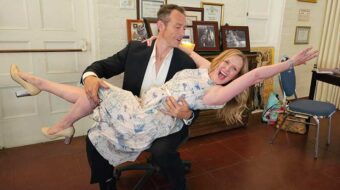
SAN FRANCISCO—Frank Capra’s film It’s a Wonderful Life opened on Christmas Day 1946. It received respectable reviews and appreciative audiences, but no one could have predicted that it would become a seasonal institution for TV audiences. Many who love the film and appreciate its life-affirming message gladly accept the ritual of watching its annual broadcast. The diehards among them can recite every line of dialogue. Today it’s listed among the top ten films of all time.

It’s now been lovingly transformed into a major opera house production (seen opening night, Nov. 17) by the team of composer Jake Heggie and librettist Gene Scheer. It’s a critical hit, written in a popular late Romantic and thoroughly American idiom, studded with little musical quotes from familiar holiday noels, high school graduation anthems, and the wild Mekee-Mekee that recalls the dance crazes of the flapper era.
Though nominated for six Academy Awards, the film won only one, for Technical Achievement. Capra’s tech crew devised a new method of simulating falling snow on motion picture sets, abandoning the old system of dropping crushed corn flakes painted white that produced an audible crunch when stepped upon, meaning that all those wintry scenes had to be dubbed separately.
As most readers likely know, the “wonderful life” belongs to George Bailey, the accidental lead officer of Bailey Brothers’ Building and Loan in the small town of Bedford Falls, N.Y., who reaches mid-life after a career of fighting off the predations of Henry F. Potter, richest man in town and owner of the bank and most of the overpriced rental property for its residents. Potter is a kind of “Mr. Mister” (from the musical The Cradle Will Rock), or like Orson Welles’s “Magnificent Ambersons,” about whom the townspeople are forever muttering, they’ll “get their comeuppance.” A little matter of a missing $8000 from the firm thanks to Uncle Billy’s absentmindedness threatens to call down the force of the law on George, who, after a lifetime of self-abnegation and putting his neighbors’ and clients’ interests before his own family’s, comes to the brink of suicide once Potter assures him he’s “worth more dead than alive.” Thanks to the attentions of Angel Second Class Clarence Odbody, who after 200 years in heaven and not having yet earned his wings, George is saved from the edge, and the townsfolk all pitch in to make up the shortfall and more.
The Building and Loan operated as a community self-help project whereby the collective power of neighborly investment helped secure first homes for scores of families. It was for home finance what the traditional “barn raising” was for farming families: The whole town pitched in because next time it will be your barn they’re helping to erect. The B&L held the community together in fast bonds of solidarity.
The theme was bound to resonate in the immediate post-war era when returning GIs sought to establish themselves with their new “war brides” in such “Bailey Parks” all over the country (read: the growth of suburbia as a new geographic and demographic idea). Frank Capra himself served in the U.S. Army from 1941 to 1945, when he created the series of short films “Why We Fight” to explain American participation in the war. Although before we get too misty-eyed, we must acknowledge how discriminatory the GI Bill and perhaps such B&L societies were to veterans who were members of minority groups; a point is made, however, to include some “ethnic” names among the homeowners.
The bold questions about capitalist methods and ethics that the film raised did not escape notice from one informant. “On May 26, 1947,” according to the Wikipedia entry on the film, “the FBI issued a memo stating, ‘With regard to the picture It’s a Wonderful Life, [redacted] stated in substance that the film represented rather obvious attempts to discredit bankers by casting Lionel Barrymore as a ‘scrooge-type’ so that he would be the most hated man in the picture. This, according to these sources, is a common trick used by Communists. [In] addition, [redacted] stated that, in his opinion, this picture deliberately maligned the upper class, attempting to show the people who had money were mean and despicable characters.” “Film historian Andrew Sarris,” as Wikipedia also says, “points out as ‘curious’ that the censors never noticed that the villainous Mr. Potter gets away with robbery without being caught or punished in any way.” For indeed, Uncle Billy had inadvertently tucked the missing $8000 into a newspaper left at Potter’s office.
Barrymore had in fact played Ebenezer Scrooge in Dickens’s A Christmas Carol, and was an obvious choice for the Potter role. George Bailey was indelibly played by the lovable James Stewart.
Was it in any way a response to the national disgust with the likes of Henry F. Potter that the U.S. Post Office in 1950 issued a 75th anniversary 3-cent commemorative (in dollar-bill green) honoring the Americans Bankers Association? It depicted a smoke-billowing factory in the background and a homey farmhouse with a barn in the foreground, as if to underline, You see, the banks are the people’s friend.
The film has various times been turned into radio productions, stage plays and musicals. The Heggie opera is the first in this genre. Among Heggie’s 13 musical stage works to date, two, seen in Southern California, have been reviewed in People’s World, his Moby-Dick and Great Scott.
In the opera the main change from the film is that the angel Clarence is now a high soprano Clara (Golda Schultz). According to the composer, he simply did not want to write his opera for two principal male voices. This is, however, not an entirely original idea. In a 1977 version for TV, It Happened One Christmas, Marlo Thomas played the protagonist Mary Bailey Hatch, and Cloris Leachman was the angel Clara Oddbody, with Orson Welles as Mr. Potter.
Some of the minor townspeople are omitted from the opera (they’ll none of them be missed), so that the focus is more squarely on the Bailey family, Potter, and Clara. George is sung with grace and ardor by William Burden, and his adoring, loyal wife Mary is a radiant Andriana Chuchman. The diligent guardian angel is often accompanied in her wanderings down on Earth by a quartet of already bewinged angels (soprano Sarah Cambridge, mezzo soprano Ashley Dixon, tenor Amitai Pati, and bass baritone Christian Pursell). Their “superior” (God? Head Angel?) is the recorded voice of Patti LuPone. The evil Potter is portrayed by opera veteran, baritone Rod Gilfry in fine, insinuating voice. George’s brother Harry is a virile war hero, baritone Joshua Hopkins, and his wife Helen is Carole Schaffer. Keith Jameson sings the touching role of Uncle Billy. Many, though not all, are veterans of the Houston production. New to the production is the honeyed voice of South African soprano Schultz, who also adds a touch of color that is otherwise in short supply in Bedford Falls.
The opera was a co-commission between San Francisco Opera, Houston Grand Opera and the Indiana University Jacobs School of Music. The opera bases itself not only on the Capra film but also on its source, The Greatest Gift, a story by Philip Van Doren Stern. Houston (2016) and Indiana (2017) have already produced the opera, and the creators have made improvements from these “try-outs” for the presumably now final version seen in San Francisco’s West Coast premiere. The running time is two and a half hours, with one intermission. For those eager to “compare and contrast,” a commercial recording of the Houston production is available.

Since we are inhabiting a world that is part heavenly and part earthly, the scenography is an all-important element. Set designer Robert Brill has fashioned an otherworldly atmosphere featuring doors as its principal motif—doors representing all the days and events of George’s life, that open and close and fill in as props in a seemingly infinite variety of ways. Angels confer in the upper stratosphere of the stage, ascending and descending (as angels will) through the magic of inventive staging. The skies twinkle with stars and snow. The entire production, with a total of 56 singers, actors, dancers and one supernumerary, is directed by Leonard Foglia, who has served this project from the start. It is a visual, musical and dramatic delight from beginning to end, suitable for all audiences.
The scene in which Clara shows George what the world would have looked like if, as he claimed to wish, he’d never been born, is performed without music, and is also conducted in black and white, showing how colorless and cold Bedford Falls would have been without his amazing grace. In place of Bailey Park, the town has been renamed Pottersville, inhabited by people in their own private hells. It’s a stark episode, a ruminative cadenza, before the final fireworks. In reality, there are “Pottersvilles” all over America, places of despair and hopelessness.
Only on a small point or two I might have asked for more clarity. The climactic moment when the $8000 is misplaced did not receive adequate emphasis. Perhaps the creative team was convinced that everyone knows the story well enough not to have to put this moment in greater relief, but I had forgotten that piece, and my opera companion had in fact never seen the film at all. It was left to Clara later to verbally make the observation that Potter stole the money, but the original staging of the incident deprives the audience of this inside knowledge.
Now it’s been some years since I last saw the film, and I do not recall whether or not Potter was portrayed as a person using a wheelchair. But he is here, and I question that. Perhaps a point is being made that his rotten capitalist business practices are a factor of some deep grudge against society he nurtures, possibly on account of the illness or accident that landed him in the wheelchair, but if so, this tack is not pursued and in any case is a rather gratuitous statement to make. What we are left with is the only person with a visible disability being a stealing SOB, and that makes me a little uncomfortable. (George lost his hearing in one ear as a plot point, which exempts him from going off to WWII.)
Finally, at the end I believe the creative people, as well as conductor Patrick Summers, who has led a number of Heggie’s works from the pit, chose unwisely inviting the entire audience to be able to claim, “I sang with the San Francisco Opera” by playing “Auld Lang Syne” and asking the audience to sing along to the projected words. In the first place, I was personally too emotionally affected by the opera’s glorious conclusion to even try singing through the lump in my throat; and in the second place, why spoil that magnificent last scene by such a patently hokey holiday gimmick suited to a “community sing” but not as the finial to a stunning work that should be allowed to stand on its own? Plus, is “Auld Lang Syne” right for Christmas anyway? I truly hope that will not become standard practice for future productions of this deeply moving opera.
This strong new work takes its place alongside another new “holiday” opera, Silent Night, about that Christmas Eve in 1914, the first during WWI, when soldiers on all sides spontaneously stopped the war to pray, sing and exchange gifts together. Both are large productions, Wonderful Life especially, which many opera company budgets may not be able to handle. Perhaps a chamber version for reduced orchestra might be made available in the future. Owing to the size of these works, they may never supplant Menotti’s shorter Amahl and the Night Visitors or the ever-lovely Hansel and Gretel by Engelbert Humperdinck (the first one), but at least serious opera producers have some worthy options for December audiences.
Heggie was attracted to the universality and timelessness of the story. “I don’t know when It’s a Wonderful Life actually came to mind, but I knew it was exactly the story I wanted to pursue: an American classic about the ripple effect of good deeds in a community. Isn’t that a message we always need?”
“The circumstances are familiar and the message eternal,” he says. “‘No one is a failure who has friends,’” he quotes from the libretto. “It’s about how you measure contentment and happiness in this precarious world.”
It’s a Wonderful Life will be performed nine times in all. Remaining performances are Nov. 20, 24, 25, 29, and Dec. 1, 4, 7 and 9. For tickets visit sfopera.com, call (415) 864-3330, or visit the box office at the War Memorial Opera House, 301 Van Ness Ave., San Francisco. A pre-opera talk takes place before each performance, 55 minutes before curtain. The opera is performed in English and has English titles.












Comments